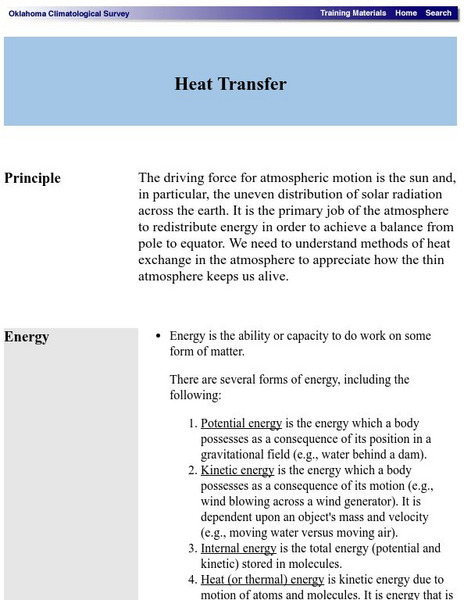Concord Consortium
Concord Consortium: Where Does All the Energy in an Explosion Come From?
In this module Activity 4 investigates How does a spark trigger an explosion?
PBS
Pbs Kids: Colored Water Convection
This PBS site allows users to learn more about water convection as they discover how to demonstrate the way convection currents form. A fun science project!
Other
American Coal Foundation: Lesson Plan: Generating Electricity From Coal
This two-part lesson teaches learners about the process of generating electricity from coal and helps them research and discover alternate ways for using coal to produce electricity.
Concord Consortium
Concord Consortium: What Are Factors That Affect How Strongly Objects Interact With Each Other?
Explore and use models of electric fields to explain how charged objects interact with other objects.
Concord Consortium
Concord Consortium What Are All Materials Made Of?
Activity of 1 of this module explores Can the same piece of paper be cut into pieces indefinitely? The activity evaluates the particle nature of matter and uses particle nature of matter to explain observations of liquids and gasses.
Concord Consortium
Concord Consortium: What Is Happening When a Spark Occurs?
Activity 1 in this module investigates Can my finger start a fire?
Concord Consortium
Concord Consortium: What Are Nature's Building Blocks?
Activity 4 What are the electrons? This question is answered in the context of Niels Bohr's model and the probability model of atomic structure.
Concord Consortium
Concord Consortium: What Are Nature's Building Blocks?
Activity 3 of this module investigates: How do we know what's inside an atom? From Ernest Rutherford's Gold Foil Experiment to his investigation of the Plum Pudding model, students become aware of the Nuclear Model of an Atom. Also in...
Concord Consortium
Concord Consortium: What Are Nature's Building Blocks?
Activity 2 of the module explores: If you can't see it, how do you know it's there? Activities include the concepts of J.J. Thomson, electrons, and the Plum Pudding Model of the Atom.
Concord Consortium
Concord Consortium: What Are Nature's Building Blocks?
Activity 1 of this module explores What are the particles that make up all substances, and how small are they? A history of the atom is included.
Concord Consortium
Concorde Consortium: What Are All Materials Made Of?
Activity 4 of this module determines: Which model best supports our observations? This activity reviews the evidence gathered in this investigation and considers how that evidence informs your model of matter. A timeline of the history...
Concord Consortium
Concord Consortium What Are All Materials Made Of?
Activity 3 of this module explores: Is the particle model always better? Models are considered most useful when a variety of observations can be explained. A model of matter should explain observations of all types of matter. In this...
Concord Consortium
Concord Consortium What Are All Materials Made Of?
Activity 2 of this module explores: Does 5 + 5 always equal 10? In this activity liquids are mixed together and evaluated whether the continuous or particle model of matter provides a better explanation of observations of the behavior of...
Concord Consortium
Concord Consortium What Are Materials Made Of?
Activity 1 in this module explores Can the same piece of paper be cut into pieces indefinitely? The activity evaluates particle nature of matter and uses particle nature of matter to explain observations of liquids and gasses.
Concord Consortium
Concord Consortium What Are Nature's Building Blocks?
The module will develop, revise, and interpret representations of atomic structure and interactions of charges within atoms. The following activities will be explored: Activity 1. What are the particles that make up all substances and...
Concord Consortium
Concord Consortium: How Can a Small Spark Start a Huge Explosion?
In this module Activity 2 investigates What holds the atoms of a molecule together?The activity will explore what holds atoms together and why they from a molecule. Bonus reading includes Same Molecules but Different Representations.
Concord Consortium
Concord Consortium: What Makes Water Special?
Activity 4 investigates How does electron distribution impact our observations? Students have described how properties of molecules change depending on what atoms make up the molecule. In this activity students will use those ideas to...
Concord Consortium
Concord Consortium: What Makes Water Special?
Students will develop explanations connecting observations of water with properties that water exhibits through the following activities. Activity 1 How are water and other liquids similar? Activity 2 Why is water different from other...
Georgia State University
Georgia State University: Hyper Physics: Heat Conduction
Using understandable words and exceptional graphics, this page describes the transfer of energy by means of conduction. Contains several links to related topics.
Other
S Cool: Engery Flow and Nutrient Cycle
This website describes trophic levels, transfer of energy between trophic levels, pyramids of ecology, and nutrient cycles within the environment.
Oklahoma Mesonet
Oklahoma Climatological Survey: Heat Transfer
A discussion from the Oklahoma Climatological Survey of the thermal factors effecting the movement of air masses in the atmosphere. Numerous topics such as methods of heat transfer, latent heat, phase changes (including sublimation and...
Open Curriculum
Open Curriculum: Work: The Transfer of Mechanical Energy
Read this illustrated article to help you understand the concept of work in regards to the transfer of mechanical energy.
State University of New York
State University of New York: Heat Transfer Between Substances
The following simulation assesses students understanding of thermal energy, transfer and equilibrium.
CPALMS
Florida State University Cpalms: Florida Students: Some Like It Hot
Learn how heat is a form of energy that can be helpful and it can come from many sources and change form.
Other popular searches
- Energy Transfer
- Energy Transfer Diagrams
- Energy Transfer Ecosystem
- Heat Energy Transfer
- Thermal Energy Transfer
- Types of Energy Transfer
- Energy Transfer Experiment
- Food Web Energy Transfer
- Energy Transfer Assessment
- Energy Transfer Wasted
- Energy Transfer Sankey
- Energy Transfer Ecology










